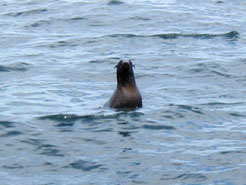
 |
With the development of the (Global
Ecology and Oceanography of Harmful Algal Blooms (GEOHAB)) Program, international
efforts to understand HABs are becoming more prevalent.
Click here to learn more about South African HABs.
|
|
Researchers from Bigelow Laboratory for Ocean Sciences are involved in
a collaborative project with scientists from South Africa to study
harmful algal blooms in the southern Benguela upwelling region.
Dr. Collin Roesler and Stacey Etheridge (Univ. of Connecticut) have joined
Dr. Grant Pitcher and his team from
Marine and Coastal Management in Cape Town, South Africa for
the past two years in Lamberts Bay to investigate red tides (>>>).
Blooms are generally absent in this area during their winter season
(June through August) and have the highest frequency at the end
of their upwelling season (January through April), thus field studies
are often conducted in February and March.
|
|
2000 FIELD SEASON
|
| During the field season from February and March 2000, there were large algal blooms forming red tides; however, they were not toxic and did not cause any harmful effects. The blooms consisted primarily of the dinoflagellates Gymnodinium sp., Ceratium furca, and Ceratium lineatum. Sample analysis and data processing are currently underway to determine what causes these blooms, what conditions stimulate particular species to dominate, and how they can be detected optically. |
|
2001 FIELD SEASON
|
|
In 2001, red tides were again detected and were caused by a variety of species. In fact, one of the red tides was formed by the ciliate Mesodinium rubrum. The interesting thing about this species is that it contains cryptophytes as endosymbionts. The cryptophytes contain a distinct pigment composition with phycoerythrin that can be easily distinguished from other species. This means there is great potential for these blooms to be detected via remote sensing. Other red tides were caused by the toxic dinoflagellates Dinophysis and Gymnodinium. Several people were hospitalized from eating contaminated mussels and others experienced DSP symptoms from being in direct contact with bloom water even though they had not eaten shellfish. This suggests that the okadaic acids may be present in aerosols, a topic that will need further investigation. Even though DSP was a problem for humans, the marine life didn’t appear to be impacted (>>>). The approach was to investigate the plankton community and the chemical and physical environment on the same scales. Our goal: to determine what factors are responsible when a bloom occurs and which species dominate the bloom. Offshore and alongshore transects were performed in order to determine the spatial extent of blooms. Moorings were also deployed to collect a time series at one location (>>>). One advantage to having time series data is that tidal effects can be accounted for. Sample analysis and data processing from this trip is just beginning and will likely lead to more questions and further investigations. We hope that such international collaboration will continue well into the future. |
   |
|


